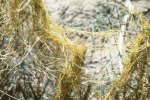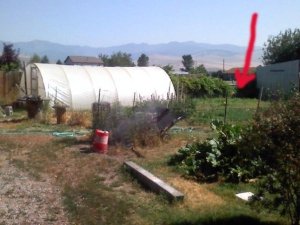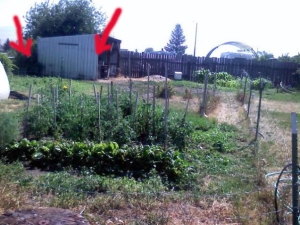I may just have to stop reading my gardening literature. Twice in the last few weeks, I have read about a garden problem and then stumbled across it in my own plot just days later.
It started with the fall issue of Zone 4 magazine, where I read an article about raspberries. The berry expert profiled in the article mentioned that yellowjackets can be quite troublesome in raspberry patches, burrowing into the fruit and sucking it dry. “Note to self,” I thought, since my raspberries are coming along nicely and should produce well next year. I filed the tidbit away for future use. Not two days later, I wandered out to my strawberry patch, to find it literally buzzing with yellowjackets, sucking the life out of my STRAWBERRIES!! Ugh. I bought a trap, which has since accumulated quite a collection of corpses. But not before they laid waste to just about every beautiful berry on the plants. Damn, damn, damn!
 A few days later, I was perusing my “Weeds of the West” reference book, trying to figure out if what was growing in one of my perennial beds was yarrow (it was common tansy). While flipping through the book, I came across a yucky-looking weed called Dodder. It looks like thin yakisoba noodles, draped all over the host plant. “Ick,” I thought, and quickly turned the page. This weekend, while weeding my garden with the help of my sister and her husband, we discovered the nasty stuff draped all over my corn! I was so mad….like irrationally mad. This weed is a parasitic annual, which explains why my corn had been looking a little iffy. We pulled it out and stuffed it in a garbage can, but I haven’t had the chance to go back out to inspect the damage. Here’s the thing though…further research this evening shows that corn is supposed to be resistant to dodder. Something’s not adding up. Anyone have any ideas? My next step is to go pull out all my corn, just as it’s setting ears….
A few days later, I was perusing my “Weeds of the West” reference book, trying to figure out if what was growing in one of my perennial beds was yarrow (it was common tansy). While flipping through the book, I came across a yucky-looking weed called Dodder. It looks like thin yakisoba noodles, draped all over the host plant. “Ick,” I thought, and quickly turned the page. This weekend, while weeding my garden with the help of my sister and her husband, we discovered the nasty stuff draped all over my corn! I was so mad….like irrationally mad. This weed is a parasitic annual, which explains why my corn had been looking a little iffy. We pulled it out and stuffed it in a garbage can, but I haven’t had the chance to go back out to inspect the damage. Here’s the thing though…further research this evening shows that corn is supposed to be resistant to dodder. Something’s not adding up. Anyone have any ideas? My next step is to go pull out all my corn, just as it’s setting ears….

 At two households that have, for all practical purposes, been in fallow for years (visual of one), the lords of the land are letting us fill the void by weeding or tilling, llama manuring or composting, and planting this week.
At two households that have, for all practical purposes, been in fallow for years (visual of one), the lords of the land are letting us fill the void by weeding or tilling, llama manuring or composting, and planting this week.